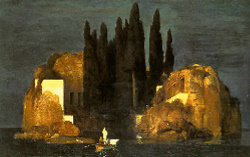 |
|
The Isle of
the Dead
by
Arnold Bocklin
The Isle of the Dead
by Sergei Rachmaninoff
| |
A
widow shrouded in white accompanies her husband's draped coffin in a
rowboat to a rocky island whose cliffs are carved with tomb
chambers. Bocklin painted five versions of "Island of the
Dead" between 1880 and 1886. The image became widely known
through poor color reproductions and a freely adapted etching of the
1890s. It is thought that Rachmaninoff only saw a reproduction --
possibly in black and white -- in 1907.
|
|
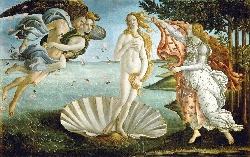 |
The
Birth of Venus
by Sandro Botticelli
Three Botticelli Pictures
by Ottorino Respighi | |
Botticelli was commissioned to paint the work
("La Nascita di Venere") by the Medici family of Florence. It depicts the goddess
Venus, having emerged from the sea as a fully grown woman, arriving at the sea-shore.
The painting was completed in
in 1486, and inspired the third of Respighi's Three Botticelli
Pictures. The other two paintings referenced in Respighi's work are '"La
Primavera" (Spring) and "The Adoration of The
Magi."
|
|
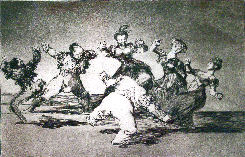 |
| Figures
Dancing in a Circle
from Los Disparates (1816-23)
by Francisco de Goya
Goyescas
by Enrique Granados
| |
Composer Enrique Granados was
inspired by the works of 18th-19th century painter Francisco Goya--specifically
from a set of sketches of Spanish life that Granados had seen in the
Prado museum in Madrid. In Goyescas, the composer celebrates the Spanish
national character in Goya's work, but does not single out any one
painting by the artist.
|
|
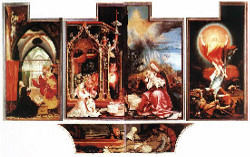 |
|
Altarpiece in Isenheim
by Matthias Grunewald
Symphony "Mathis der Mahler,"
by Paul Hindemith
| |
In 1933, German composer Paul Hindemith was working on an opera based on the life of 16th century painter
Matthias Grunewald, who had believed his creative output stood above the politics of his
time. Hindemith first produced a symphony based on themes from the
opera, depicting scenes from Grunewald's famous 16th century altarpiece in
Isenheim, with the second movement focusing on the image of Christ being laid in the tomb.
|
|
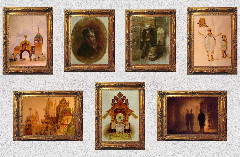 |
| Paintings by
Victor Hartmann
Pictures at an Exhibition
by Modest Mussorgsky
| |
Hartmann had a varied career,
illustrating books, working as an architect, and a watercolorist, focusing on Russian motifs, before his early death from an aneurysm at the age of
39. The exhibition of over 400 of his paintings was displayed in the Academy of Fine Arts in St Petersburg, in February and March 1874.
While attending the exhibition, Hartmann's friend, Modest Mussorgsky decided to write a piano cycle suggested
by what he had seen.
|
|
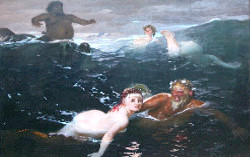 |
| Play of the
Waves
by Arnold Bocklin
Play of the Waves
by Max Reger
| |
Painted in 1883, after
Bocklin had been swimming in Italy with a friend who dove into the waves, swam some distance underwater, and suddenly resurfaced,
to the surprise of a group of women in a bathing party. Bocklin decided to portray a similar scene drawn from the world of mythical underwater creatures.
The German title [Im Spiel der Wellen] is sometimes translated as
"Playing in the Waves."
|
|
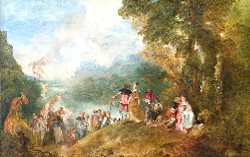
|
| The
Embarkation for Cythera
by Jean-Antoine Watteau
L'Isle Joyeuse
by Claude Debussy
| |
The Embarkation for Cythera
is a 1717 painting by the French Rococo artist Jean-Antoine Watteau.
The island of Cythera was considered the birthplace of Venus, thus these
'daytrippers' symbolize the brevity of love. Debussy's 1905 L'Isle
Joyeuse captures that same erotic sensibility.
|
|

|
| The
Pleasures of Love
by Jean-Antoine Watteau
Les Biches
by Francis Poulenc
| |
Watteau excelled in his depictions of
revelry and pleasure, balls, picnics, hunts, dancing and the seductive
chase, focusing on the diversions of the leisured class in their most favorable
light. In The Pleasures of Love, critics (and Poulenc) saw
a portrayal of King Louis XIV flirting with various women in his Parc aux
biches-or deer park--at Versailles.
|
|
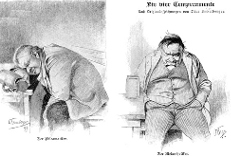
|
The Four
Temperaments
by Otto Bromberger
Symphony No. 2
"The Four Temperaments"
by Carl Nielsen
| |
The crude painting that
inspired composer Carl Nielsen is unknown, but given the location in a
country tavern, it might have been similar in content to this illustration by Otto
Bromberger (1862-1943). When you click on the image above, you
will see all four personality types: Phlegmatic (relaxed, quiet, even
sluggish), Melancholic (introverted and given to thought), Choleric
(ambitious and leader-like), and Sanguine (sociable and
pleasure-seeking).
|
|